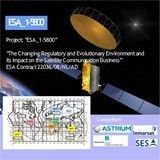
-
StatusCompleted
-
Status date2012-09-05
-
Activity Code1A.045
The fast growing demand on frequency spectrum for the provision of broadband mobile radio services increases the competition for the allocation and potential sharing of frequency spectrum allocated to the Mobile-, Fixed-, and Broadcasting Satellite Services (MSS/FSS/BSS).
This project supports ESA in light of a changing regulatory and technically evolutionary environment in defending the needs of the satellite communication community to maintain future availability of and to maintain growth potential of frequency spectrum needed for the provision of satellite communication and broadcasting services. The project supports the studies in the regulatory domain at national, regional (CEPT), and international (ITU-R) level to find and promote additional allocations for the MSS and BSS domain under Agenda Items for the WRC-12.
Other major objectives are to investigate the potential impact of software defined radios and cognitive radio systems on future radio regulations, and to examine the impact of CGC in the 1.5-1.6GHz MSS bands.
Eight key issues are tackled:
- Fact finding of currently existing frequency spectrum resources allocated to the mobile (MSS), fixed (FSS), and broadcasting (BSS) satellite service;
- The impact of service convergence on potential future radio regulation;
- Support on the analyses of the use of frequency spectrum in the 21GHz BSS band;
- Investigations on software defined radio (SDR) and cognitive radio systems (CRS) enabling flexible spectrum management scenarios and their potential impact on future radio regulations;
- Additional spectrum allocations for MSS;
- Analysis and consequences of the EC Directives on BWA;
- The regulation for the use of complementary ground components in MSS L-band systems, and
- Analysis on the current and potential future use of Ka-band spectrum for satellite communication in the CEPT member states.
The expected main benefits will comprise to protect SatCom frequency spectrum from sharing with other radio services and to envisage further allocations to ensure sufficient growth potential for new mobile and broadcasting satellite services.
The main features of this study result in the clarification and promotion of eight key SatCom items in the regulatory domain, of which three deal with regulation in the European Union while the other cover issues in preparation of Agenda Items to be dealt with at the next World Radiocommunication Conference 2012.
The first group of issues is relevant in the European Community with a need to comment on European Directives for the use of Broadband Wireless Access (BWA) in the bands 3.4-3.8GHz restricting seriously the use the satellite FSS C-band (3.4-4.2GHz) earth stations.
The study, in support of the following WRC-12 Agenda Items (A.I.), will:
- Investigate the impact of service convergence in line with Resolution 951(WRC07) and the impact on SatCom frequencies (A.I. 1.2),
- Follow the technical and regulatory studies on the harmonisation of spectrum usage in the band 21.4-22GHz taking new developments in the 3D/HDTV-technology into account (A.I. 1.13),
- Investigate the impact of software defined radio (SDR) and cognitive radio system (CRS) on future radio regulations taking options for flexible spectrum management (FSM) into account (A.I. 1.19),
- Investigate options for additional spectrum allocations to the MSS with a particular focus in the frequency range 4-16 GHz (A.I. 1.25).
The study investigates the impact of Complementary Ground Components (CGC) considered by some MSS systems to extend their service availability into areas of critical RF propagation (urban canyons, in-door, tunnel, etc.). This investigation puts emphasis on the options for using CGCs in MSS L-band (1.6/1.5GHz) in Europe while carefully watching the developments in the US.
Since the study follows closely the on-going study process in preparation of the next World Radiocommunication Conference in 2012, the majority of activities are aligned with corresponding meetings of the regional preparatory and ITU-R meetings. Key elements of this study, besides providing contributions to these processes, are three Workshops that were convened to develop and coordinate positions on each issue to achieve a coherent approach among the promoting stakeholders on SatCom agenda items.
Workshop#1 on FS/MS(BWA)/FSS regulation in the European Community at ESTEC, Noordwijk, The Netherlands (23rd February 2009)
Workshop#2 on Software Defined and Cognitive Radio Systems and their potential impact on future Radio Regulations in support of WRC-12, Agenda Item 1.19 at Fraunhofer Institute (IIS), Erlangen, Germany (10th September 2009).
Workshop#3 on the need for more frequency spectrum allocated to the MSS in support of WRC-12, Agenda Item 1.25 convened in Berlin, Germany before the CEPT Conference Preparatory Group (CPG) meeting (27th September 2010).
All Workshops also contributed to working meetings of ESA’s Spectrum Management Advisory Group (SMAG). The interim final presentation was also combined with a SMAG meeting in Paris, France (25th January 2011).
Continuing work concentrates particularly on investigations on the European studies on Ka-band in the frame of Project Team 44 of CEPT’s Working Group Frequency Management (WGFM) (FM44).
The main work was performed in 2008 – 2010. The support to all affected agenda items of WRC-12 has been delivered. National and CEPT positions are formally taken by concluding the preparatory process. Particular work continues in support of Ka-band studies within CEPT. Very difficult conditions for an additional allocation to the MSS in the frequency range 4-16GHz, makes the research in Ka-band even more important. The need for spectrum to provide broadband MSS still needs further support by CEPT Administrations.







